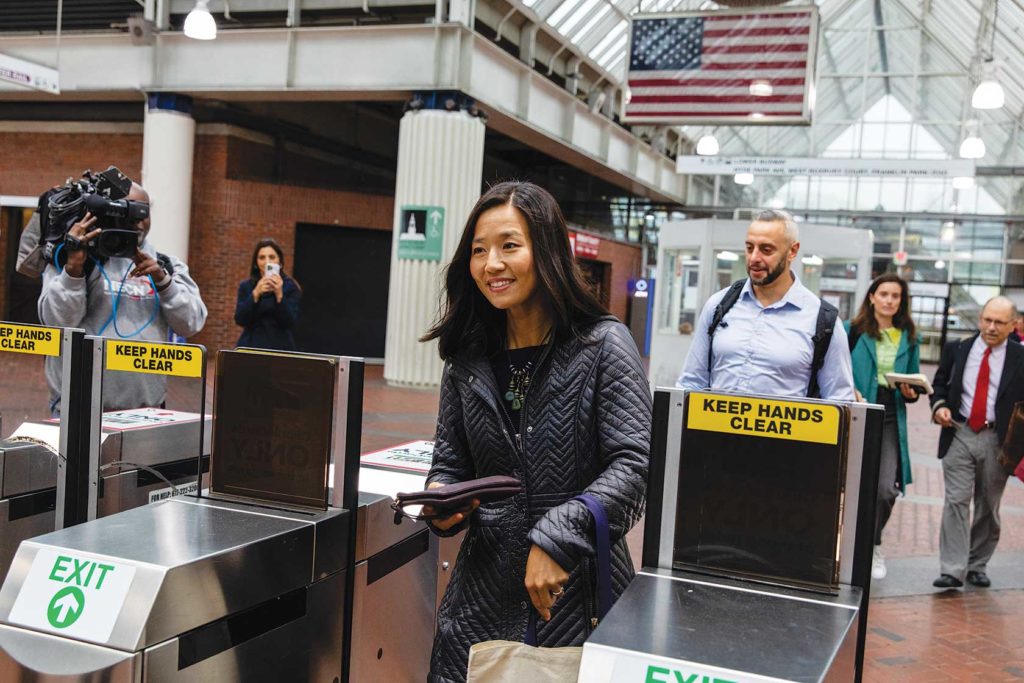
Mayor Michelle Wu and Chief of Streets Jascha Franklin-Hodge announced on Tuesday several street changes made to mitigate impacts from the MBTA’s Orange Line shutdown will be made permanent following the reopening of the Orange Line Monday. The Boston Transportation Department installed priority bus lanes, pop-up bike lanes, and change parking restrictions along the Orange Line route. Certain infrastructure changes that improved traffic flow or public safety will remain in place. The mayor also announced street changes that will be temporarily removed and then reinstalled permanently. All other changes made during the Orange Line shutdown will be removed.
“Over the last 30 days, our city teams have been focused on measuring what’s working so we could ensure continual improvement during a stressful time of the Orange Line shutdown,” Wu said. “We’re keeping in place some of the changes that have helped with traffic flow and transit access, so that commuters will see lasting benefit above ground even as the subway comes back online. I’m so proud of the Boston Transportation Department for their hard work during this unprecedented event, and grateful to commuters across the region for their patience and input.”
“The past 30 days provided an opportunity to create new ways to use our public spaces to ease how residents move within the city,” said Franklin-Hodge. “We look forward to working with the community to take the lessons learned and apply them to future infrastructure projects that will enhance public space and improve mobility for pedestrians, people on bikes, and transit riders.”
The following street infrastructure changes will remain in place:
• Chinatown MBTA SL5 bus stop: This newly added bus stop creates a vital link for Chinatown residents to the SL5.
• Copley Square area bus lanes: These bus lanes include Boylston Street (Ring Road to Clarendon Street); Clarendon Street (Boylston Street to Columbus Ave.); St. James Street (west of Berkeley Street to Dartmouth Street). These bus lanes support the 39, 9, and 10 bus routes, which together serve more than 10,000 riders per weekday.
• South End loading zones and drop-off zones: Changes to parking restrictions in this area will remain in place for improved curbside management and reduced double parking in the unprotected bike lane.
• Jamaica Plain pavement marking and signage: This includes traffic safety elements such as “Don’t Block the Box” and parking restrictions at corners to improve visibility. These changes have shown to improve traffic safety and management.
• Boylston Street one-way for vehicles: Closing part of Boylston Street (between Amory & Lamartine) to traffic throughout the shutdown has improved safety (collisions and near-misses) along the Southwest Corridor. Reopening this stretch as a one-way street from Amory to Lamartine for vehicles will support long-term bike connectivity plans, improve safety for all modes, and reduce conflict at the high crash intersection of Boylston and Lamartine Streets.
• Huntington Avenue bus & bike priority lane: The priority bus and bike lane that was added to Huntington Avenue from Brigham Circle to Gainsborough Street has improved speed for the Route 39 bus. As a permanent lane, it will continue to support the thousands of people who ride the Route 39 bus and will improve safety for those on bikes.
• Columbus Avenue pop-up bike lane: This will remain until early December and then be removed for the season. The transportation department’s Active Transportation will continue to monitor and move barrels daily to enable street sweeping. Long-term planning is underway for a potential permanent facility. This is one of the busiest corridors for biking. Improving conditions, even on just a few blocks, can make the overall trip safer and more enjoyable.
• Bluebikes parking: The city will retain Bluebikes docks added during the shutdown, with minor modifications as needed, to keep up with record-breaking ridership numbers. The city is also exploring options to provide free or low-cost bike share service.
The pop-up Boylston Street bike lane will be in place through September 26. The permanent Boylston Street bike lane will be prioritized for installation in the spring.
The transportation department is also evaluating potential designs for additional protected bike lanes, pedestrian zones, bus lanes, and safety improvements informed by the changes that were temporarily in place during the Orange Line shutdown. These changes will undergo evaluation and engagement and be publicly announced before any implementation.
City of Boston press release






